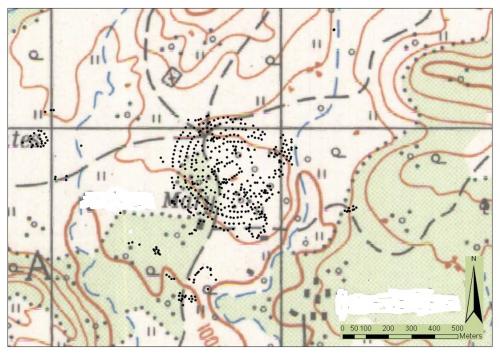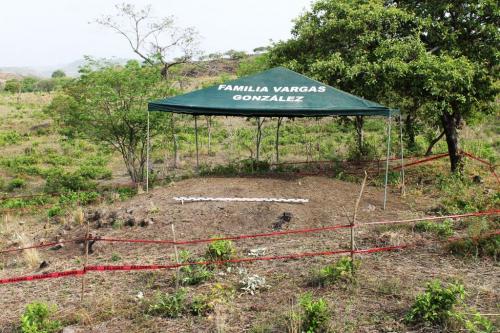Aguas Buenas
By Roosmarie Vlaskamp (2012)
The archaeological site of Aguas Buenas (Fig 1) is located north-northwest of Juigalpa, the provincial capital of the Chontales region. It is estimated that the site measures 29 hectares and is spread out over numerous small hills and along a river.
Archaeologists visiting in the 1980s approximated that the site consisted of 200 to 300 mounds (Lange et al. 1992:49) and based on surface finds they estimated that the dating of the site would be between AD 1400-1600 (Gorin 1989). Later on, materials found in several test pits indicated that this time period should be expanded to AD 400-1600 (Geurds 2009). The artifacts found were quite diverse and recognizably from different areas in Nicaragua, including the Rivas region and Northern Nicaragua, alongside a clearly more local component.
More recent research done by Alex Geurds in 2011 and 2012 has focused on mapping the site and performing test excavations, as well as trench and quadrant excavations on individual mounds. The site was discovered to be much larger in extension and number of mounds than expected, and the map generated during these field seasons (see Fig 1) is to be seen as preliminary, as during the 2013 field season mapping will be completed with a differential GPS and a Digital Elevation Model will be constructed. More surveys and excavations will then also be executed, as well as follow-up documentation and investigation of the petroglyphs present.

Fig 1 - Map of the site Aguas Buenas, the black dots represent mounds
The total amount of mounds on the site has been revised to 574 (Fig. 2), so that the site of Aguas Buenas now surpasses any other known archaeological site in Nicaragua in terms of sheer number of mounds. The cultural nature of the mounds remains undetermined, whether housing, ceremonial or both, though a multicomponent occupation has been established (Fig. 3). What is even more striking is that during the mapping of the mounds they were found to be arranged in concentric circles, and in the western part of the site the mounds form an almost perfect geometric circle. In that area the mounds are positioned almost equidistant from each other as well. The diameter of the outer circle measures some 500 meters.

Figure 2: Unexcavated mound at Aguas Buenas (photo by Richard Jansen)

Figure 3: Mound excavation at Aguas Buenas (photo by Richard Jansen)
Even though the residential component of the site remains to be precisely determined, it is to be assumed that habitation did occur at some stage. Perhaps during the Sapoá phase (AD 800-1250) due to the high amount of Sapoá phase ceramic material that was excavated from two test pits in 2009. Remarkably, in contrast to other sites in Nicaragua, no sculptures or fragments have been documented at Aguas Buenas so far. This may be for two specific reasons: one, the site is close to an urbanized area and so will have been subjected to looting from an early stage onward; or two, there are many rock art panels found all over the site and the closeness of the bedrock to the surface might have served as a substitute for the statues.
These rock art panels have been subject to an earlier survey in 1992, when Rigat surveyed distinct sectors in the Chontales province, and noted several sites with petroglyphs and including a detailed description of Aguas Buenas (Rigat 1992: 547). He noted 31 petroglyph finds, which Baker (2010: 147) categorized according to her own system for comparison to her dataset of petroglyph from Ometepe Island. She finds them to be comparable and it might be interesting to further study this likeness (Baker 2010: 147). Rigat (1992: 548-58) provides numerous drawings of the petroglyphs he encountered and many of those are recognizable in the dataset compiled in 2011. Others, however, seem to have suffered much from weathering (cultural and/or natural) over the past 19 years. A detailed study of the these petroglyphs is currently the subject of a thesis by the author (Fig. 4).

Figure 4: Anthropomorphic petroglyph

